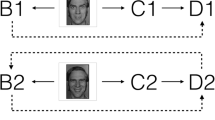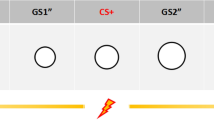Abstract
Studies suggest that fear-related responses might be acquired through the facial expressions of other individuals. The present study aimed to investigate the derived transfer of aversive functions in equivalence classes comprised of facial expressions of fear and happiness. A delayed matching-to-sample task established two equivalence classes between facial expressions of emotions and nonsense abstract stimuli: B1-A1(Fear)-C1-D1; B2-A2(Happiness)-C2-D2. After relational training (AB, AC, CD) and equivalence tests (BD, DB), the transfer of function from the faces to the D stimuli was evaluated by means of (1) a semantic differential, (2) an avoidance task, (3) US expectancy scale, and (4) valence scale. Results from the semantic differential indicated that D1 and D2 had negative and positive evaluations, respectively. Fear related measures indicated that D1 (equivalent to fear) evoked avoidance responses, was highly rated on US expectancy and was negatively valenced; in comparison, D2 (equivalent to happy) did not evoke either avoidance or US expectancy and was positively valenced. These findings indicate that the participation of fearful faces in equivalence classes leads to derived fear, including derived avoidance responses.




Similar content being viewed by others
References
Augustson, E. M., & Dougher, M. J. (1997). The transfer of avoidance evoking functions through stimulus equivalence classes. Journal of Behavior Therapy & Experimental Psychiatry, 3, 181–191. https://doi.org/10.1016/S0005-7916(97)00008-6.
Bandura, A., & Menlove, F. L. (1968). Factors determining vicarious extinction of avoidance behavior through symbolic modeling. Journal of Personality and Social Psychology, 8, 99–108. https://doi.org/10.1037/h0025260.
Bennett, M., Hermans, D., Dymond, S., Vervoort, E., & Baeyens, F. (2015). From bad to worse: Symbolic equivalence and opposition in fear generalisation. Cognition & Emotion, 29, 1137–1145.
Bennett, M., Vervoort, E., Boddez, Y., Hermans, D., & Baeyens, F. (2015). Perceptual and conceptual similarities facilitate the generalization of instructed fear. Journal of Behavior Therapy & Experimental Psychiatry, 48, 149–155.
Bortoloti, R., & de Rose, J. C. (2009). Assessing the relatedness of equivalent stimuli through the semantic differential. The Psychological Record, 59, 563–590. https://doi.org/10.1007/BF03395682.
Bortoloti, R., & de Rose, J. C. (2011). An "Orwellian" account of stimulus equivalence. Are some stimuli "more equivalent" than others? European Journal of Behavior Analysis, 12, 121–134. https://doi.org/10.1080/15021149.2011.11434359.
Bortoloti, R., & de Rose, J. C. (2012). Equivalent stimuli are more strongly related after training with delayed matching than after simultaneous matching: A study using the Implicit Relational Assessment Procedure (IRAP). The Psychological Record, 62, 41–54. https://doi.org/10.1007/BF03395785.
Boyle, S., Roche, B., Dymond, S., & Hermans, D. (2016). Generalisation of fear and avoidance along a semantic continuum. Cognition & Emotion, 30, 340–352.
Cameron, G., Roche, B., Schlund, M. W., & Dymond, S. (2016). Learned, instructed and observed pathways to fear and avoidance. Journal of Behavior Therapy & Experimental Psychiatry, 50, 106–112.
de Almeida, J. H. D., Bortoloti, R., Ferreira, P. R. D. S., Schelini, P. W., & Rose, J. C. C. D. (2014). Análise da validade e precisão de instrumento de diferencial semântico. Psicologia: Reflexão e Crítica, 27, 272–281. https://doi.org/10.1590/1678-7153.201427207.
de Almeida, J. H., & de Rose, J. C. (2015). Changing the meaningfulness of abstract stimuli by the reorganization of equivalence classes: Effects of delayed matching. The Psychological Record. 65, 451–461. https://doi.org/10.1007/s40732-015-0120-9.
de Rose, J. C., & Bortoloti, R. (2007). A equivalência de estímulos como modelo de significado. Acta Comportamentalia, 15, 83–102.
de Rose, J. C., McIlvane, W. J., Dube, W. V., Galpin, V. C., & Stoddard, L. T. (1988). Emergent simple discriminations established by indirect relations to differential consequences. Journal of the Experimental Analysis of Behavior, 50, 1–20. https://doi.org/10.1901/jeab.1988.50-1.
Dougher, M., Augustson, E., Markham, M., Greenway, D., & Wulfert, E. (1994). The transfer of respondent eliciting and extinction functions through stimulus equivalence classes. Journal of the Experimental Analysis of Behavior, 62, 331–351. https://doi.org/10.1901/jeab.1994.62-331.
Dymond, S., Bennett, M., Boyle, S., Roche, B., & Schlund, M. (2017). Related to anxiety: arbitrarily applicable relational responding and experimental psychopathology research on fear and avoidance. The Behavior Analyst, 1–25. https://doi.org/10.1007/s40614-017-0133-6.
Dymond, S., Bennett, M., Boyle, S., Roche, B., & Schlund, M. (2018). Related to anxiety: Arbitrarily applicable relational responding and experimental psychopathology research on fear and avoidance. Perspectives on Behavior Science, 41, 189–213. https://doi.org/10.1007/s40614-017-0133-6.
Dymond, S., & Rehfeldt, R. A. (2000). Understanding complex behavior: The transformation of stimulus functions. The Behavior Analyst, 23, 239–254.
Dymond, S., Roche, B., & Bennett, M. (2013). Relational frame theory and experimental psychopathology. In S. Dymond & B. Roche (Eds.), Advances in relational frame theory: Research & application (pp. 199–218). Oakland, CA: New Harbinger.
Dymond, S., Roche, B., Forsyth, J. P., Whelan, R., & Rhoden, J. (2008). Derived avoidance learning: Transformation of avoidance response functions in accordance with the relational frames of same and opposite. The Psychological Record, 58, 271–288.
Dymond, S., Schlund, M. W., Roche, B., & Whelan, R. (2014). The spread of fear: Symbolic generalization mediates graded threat-avoidance in specific phobia. Quarterly Journal of Experimental Psychology, 67, 247–259. https://doi.org/10.1080/17470218.2013.800124.
Ekman, P., & Friesen, W. V. (1976). Pictures of facial affect. In CD-ROM Retrieved from www.paulekman.com.
Fields, L., & Moss, P. (2008). Formation of partially and fully elaborated generalized equivalence classes. Journal of the Experimental Analysis of Behavior, 90, 135–168. https://doi.org/10.1901/jeab.2008.90-135.
Greville, W. J., Dymond, S., Newton, P. M., & Roche, B. (2014). Acquired equivalence and generalized suppression in a virtual reality environment. Leaning & Behavior, 42, 123–130. https://doi.org/10.3758/s13420-013-0129-3.
Hayes, S. C., Barnes-Holmes, D., & Roche, B. (Eds.). (2001). Relational frame theory: A post-Skinnerian account of human language and cognition. New York, NY: Plenum.
Hayes, S. C., Kohlenberg, B. K., & Hayes, L. J. (1991). The transfer of specific and general consequential functions through simple and conditional equivalence classes. Journal of the Experimental Analysis of Behavior, 56, 119–137. https://doi.org/10.1901/jeab.1991.56-119.
Lang, P. J., Bradley, M. M., & Cuthbert, B. N. (1999). International affective picture system (IAPS): Technical manual and affective ratings. Gainesville, FL: University of Florida, Center for Research in Psychophysiology.
Leech, A., Barnes-Holmes, D., & Madden, L. (2016). The implicit relational assessment procedure (IRAP) as a measure of spider fear, avoidance, and approach. The Psychological Record, 66, 337–349. https://doi.org/10.1007/s40732-016-0176-1.
Luciano, C., Valdivia-Salas, S., Ruiz, F. J., Rodrıguez-Valverde, M., Barnes-Holmes, D., Dougher, M. J., & Gutierrez-Martinez, O. (2014). Effects of an acceptance/defusion intervention on experimentally induced generalized avoidance: A laboratory demonstration. Journal of the Experimental Analysis of Behavior, 101, 94–111. https://doi.org/10.1002/jeab.68.
Mineka, S., & Zinbarg, R. (2006). A contemporary learning theory perspective on the etiology of anxiety disorders: It's not what you thought it was. American Psychologist, 61, 10.
Neumann, D. L., Waters, A. M., Westbury, H. R., & Henry, J. (2008). The use of an unpleasant sound unconditional stimulus in an aversive conditioning procedure with 8- to 11-year-old children. Biological Psychology, 79, 337–342.
Nicholson, E., & Barnes-Holmes, D. (2012). The implicit relational assessment procedure (IRAP) as a measure of spider fear. The Psychological Record, 62, 263–278. https://doi.org/10.1007/BF03395801.
Olsson, A., & Phelps, E. A. (2004). Learned fear of “unseen” faces after Pavlovian, observational, and instructed fear. Psychological Science, 15, 822–828. https://doi.org/10.1111/j.0956-7976.2004.00762.x.
Olsson, A., & Phelps, E. A. (2007). Social learning of fear. Nature Neuroscience, 10, 1092–1102. https://doi.org/10.1038/nn1968.
Osgood, C. E., & Suci, G. I. (1952). A measure of relation determined by both mean difference and profile information. Psychological Bulletin, 49, 251–262.
Osgood, C. E., Suci, G. I., & Tannenbaum, P. H. (1957). The measurement of meaning. Urbana, IL: University of Illinois Press.
Perez, W. F., de Almeida, J. H., de Rose, J. C., Dorigon, A. H., de Vasconcellos, E. L., da Silva, M. A., et al. (2019). Implicit and explicit measures of transformation of function from facial expressions of fear and of happiness via equivalence relations. The Psychological Record, 69, 13–24. https://doi.org/10.1007/s40732-018-0304-1.
Perez, W. F., Fidalgo, A. P., Kovac, R., & Nico, Y. C. (2015). The transfer of Cfunc contextual control through equivalence relations. Journal of the Experimental Analysis of Behavior, 103, 511–523. https://doi.org/10.1002/jeab.150.
Perez, W. F., Kovac, R., Nico, Y., Caro, D. M., Fidalgo, A. P., Linares, I., et al. (2017). The transfer of Crel contextual control (same opposite, less then, more than) through equivalence relations. Journal of the Experimental Analysis of Behavior, 108, 318–334. https://doi.org/10.1002/jeab.164.
Perez, W. F., Tomanari, G. Y., & Vaidya, M. (2015). Effects of select and reject control on equivalence class formation and transfer of function. Journal of the Experimental Analysis of Behavior, 104, 146–166. https://doi.org/10.1002/jeab.164.
Sidman, M. (1994). Equivalence relations and behavior: A research history. Boston, MA: Authors Cooperative.
Sidman, M. (1987). Two choices are not enough. Behavior Analysis, 22, 11–18.
Sidman, M., & Tailby, W. (1982). Conditional discrimination vs. matching to sample: An expansion of the testing paradigm. Journal of the Experimental Analysis of Behavior, 37, 5–22. https://doi.org/10.1901/jeab.1982.37-5.
Vahey, N. A., Nicholson, E., & Barnes-Holmes, D. (2015). A meta-analysis of criterion effects for the Implicit Relational Assessment Procedure (IRAP) in the clinical domain. Journal of Behavior Therapy and Experimental Psychiatry, 48, 59–65. https://doi.org/10.1016/j.jbtep.2015.01.004.
Valverde, M. R., Luciano, C., & Barnes-Holmes, D. (2009). Transfer of aversive respondent elicitation in accordance with equivalence relations. Journal of the Experimental Analysis of Behavior, 92, 85–111. https://doi.org/10.1901/jeab.2009.92-85.
Vervoort, E., Vervliet, B., Bennett, M., & Baeyens, F. (2014). Generalization of human fear acquisition and extinction within a novel arbitrary stimulus category. PLoS ONE, 9, e96569. https://doi.org/10.1371/journal.pone.0096569.
Author information
Authors and Affiliations
Corresponding author
Ethics declarations
Conflict of interest
The authors declare they have no conflict of interest.
Funding
The present research was supported by means of a research funding from the São Paulo Research Foundation on behalf of William F. Perez (FAPESP 2016/05935-6). The second author was supported by a post-doc fellowship from the São Paulo Research Foundation (FAPESP 2017/10037-0). Preparation of the manuscript was supported by grants from the Brazilian National Research Council (CNPq, Grants 573972/2008-7 and 465686/2014-1) and the São Paulo Research Foundation (FAPESP, Grant 2014/50909-8), for Instituto Nacional de Ciência e Tecnologia sobre Comportamento, Cognição e Ensino (INCT-ECCE), chaired by Deisy G. de Souza (UFSCar).
Ethical approval
All procedures performed in studies involving human participants were in accordance with the ethical standards of the institutional and/or national research committee and with the 1964 Helsinki declaration and its later amendments or comparable ethical standards. The research is approved by the Brazilian platform for ethical committees (Plataforma Brasil, CAAE # 54489116.4.0000.5504).
Informed consent
Informed consent was obtained from all individual participants included in the study.
Availability of Data and Materials
Data and materials can be provided via email to the first author or via ResearchGate (https://www.researchgate.net).
Additional information
Publisher’s Note
Springer Nature remains neutral with regard to jurisdictional claims in published maps and institutional affiliations.
Rights and permissions
About this article
Cite this article
Perez, W.F., de Almeida, J.H., Soares, L.C.C.S. et al. Fearful Faces and the Derived Transfer of Aversive Functions. Psychol Rec 70, 387–396 (2020). https://doi.org/10.1007/s40732-020-00390-6
Published:
Issue Date:
DOI: https://doi.org/10.1007/s40732-020-00390-6




